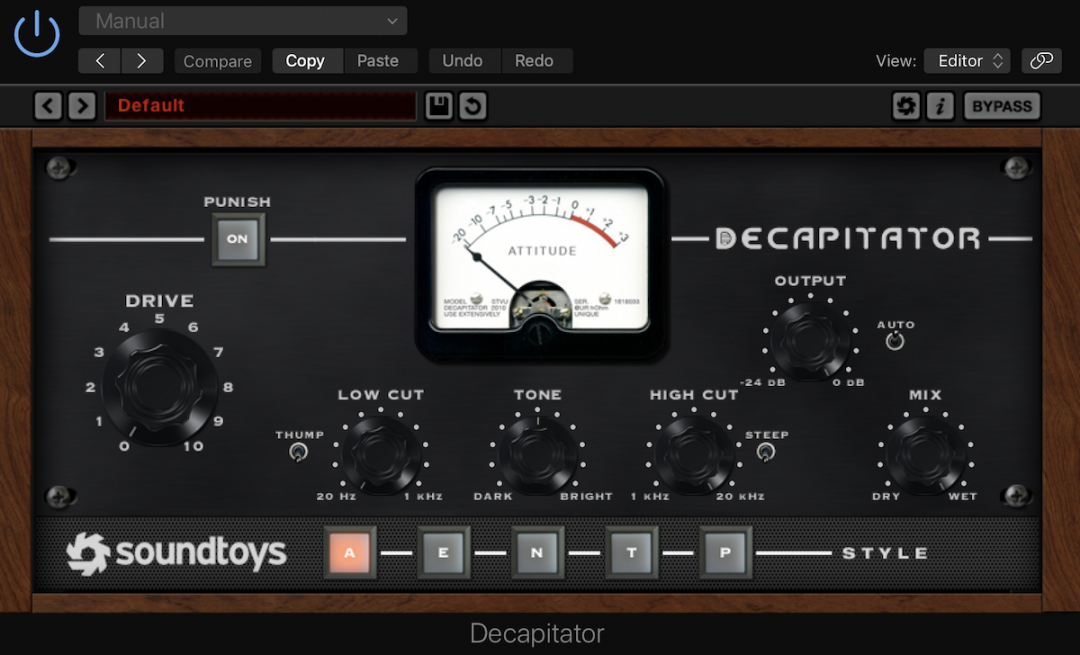Soundtoys Decapitator is one of the most popular saturation plugins on the market. It gives mixers plenty of variety and control in an easy-to-use package. It can do everything from giving an instrument a bit of analogue character to ‘punishing’ the signal with brutal distortion. It’s great!
Soundtoys Decapitator Overview
In preparing to make Decapitator, the folks at Soundtoys analyzed a bunch of different hardware—consoles, preamps, input channels, EQs, compressors, and studio distortion units. Then they narrowed down the pieces of gear they thought had the most distinctive sound and character when used both gently and at their limits.
Soundtoys then narrowed it down once again to their 5 favorite hardware units. Those are the ones that Soundtoys modeled for the A, E, N, T, and P styles in the plugin. From there, you have a simple Gain control, Low- and High-Cut filters, a Tone knob from dark to bright, and a Mix blend for quick and easy parallel processing. Naturally, there’s a Punish button too, for when you need to take things way over the top…
Part of what makes Soundtoys Decapitator so great is the fact that Soundtoys took the time to really understand saturation. They know that it’s truly the heart of what makes analogue gear sound so good to people. Tubes, transistors, and circuitry being pushed to the limit has been the key ingredient in great-sounding analogue recordings for decades.
These days, engineers use saturation in-the-box to add some of that grit back to pristine digital recordings, to increase perceived loudness, to add richness to a signal, or to totally destroy something with distortion. And Decapitator does all of that with ease.
Decapitator ‘Styles’
- A: Modeled after the Ampex 350 tape drive preamp. The 350 tape machine was a studio fixture throughout the ’50s, and eventually the preamps on these machines were pulled out, re-wired, and used as standalone mic pres. The character you get from this emulation is smooth.
- E: Modeled after the Chandler/EMI TG Channel, based on classic EMI consoles. The sound is beefy in the lows, and smooth and silky in the highs.
- N: Modeled after the Neve 1057 input channel. This is an early Neve with a very unique character compared to the ubiquitous 1073. The 1057 was built around Germanium transistors (like fuzz pedals), so they have a distinctive sound, especially on guitars.
- T: Modeled after the Thermionic Culture Culture Vulture triode setting. The Culture Vulture was the first dedicated studio distortion device. Triodes add even harmonic distortion to the signal and are usually in the preamp section of a guitar amp, for instance; the sound is punchy with an attitude.
- P: Modeled after the Thermionic Culture Culture Vulture pentode setting. This style models an overdriven pentode tube, which is commonly used in the output stage of guitar and other amplifiers. Pentodes deliver odd harmonic distortion, so they sound different compared to triodes.
Aliasing with Soundtoys Decapitator?
There’s been a bit of an online frenzy in recent years regarding aliasing and the Soundtoys Decapitator. Aliasing is a type of artifact created by digital recordings systems when a signal above half the sample rate is generated. The system creates ‘ghost’ frequencies in a lower octave, or it will just sound like nothing because these frequencies aren’t being accurately captured and recorded.
Some users working at the minimum sample rate of 44.1 kHz have evidently reported noticeable aliasing using Decapitator. This notion was apparently perpetuated by a video in which a YouTuber/engineer tried to explain why digital saturation doesn’t sound good, or doesn’t do what plugin developers say it does.
Independent tests on forums have proven to demonstrate aliasing when using Soundtoys Decapitator, but at an inaudible level. However, multiple instances of the plugin have led some to believe the cumulative effect of aliasing has reduced the quality of their mixes.
This is highly dependent on how well trained an engineer’s ears are, and ultimately how well trained their audience’s ears are. By and large, no one is going to call you out for aliasing because you used Soundtoys Decapitator on a mix. But, it’s always best to try it out yourself and see if you notice any artifacts or overall quality degradation.
- SEE ALSO: A Few of the Best Saturation Plugins
- SEE ALSO: Soundtoys Little AlterBoy Review: The Best Pitch Shifter VST?
Mastering with Soundtoys Decapitator
Q: Can you use Decapitator as a mastering grade saturation plugin?
A: Yes.
There’s plenty of flexibility in the plugin to add some subtle saturation at the mastering stage. Consider the Analog Designs Black Box, for example, which is a dedicated mastering saturation hardware unit/plugin. The primary sources of saturation in that box are pentode and triode tubes, which Decapitator emulates itself.
Really, though, any of the styles would suffice. The Ampex tape preamp setting can add some smooth saturation, as could either the EMI or Neve channels settings. Experiment with various subtle Decapitator settings and you’ll surely land on something that adds a bit of body and more perceived loudness for mastering.
READ ALSO: Best Computer for Music Production
READ ALSO: 9 Best Open Back Headphones for Mixing
READ ALSO: What Is Metadata and Why Does It Matter?
